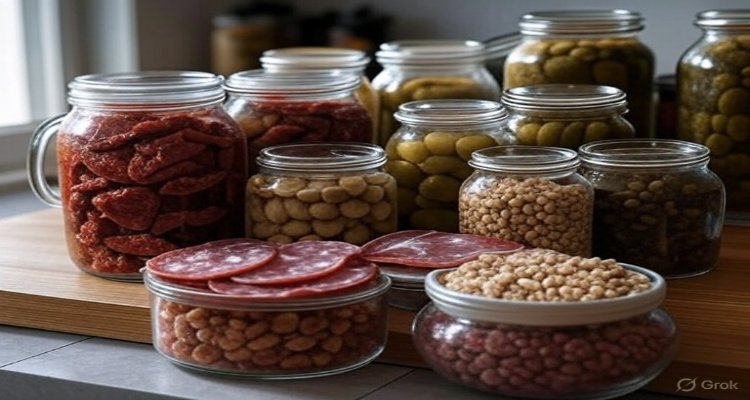The Forgotten Food Storage Methods That Work Better Than Fridges
Discover ancient food storage techniques that outperform modern refrigeration for sustainability, shelf life, and nutrition—reviving forgotten methods for a better kitchen.
Introduction: A Forgotten Art in Every Pantry
In a world dominated by buzzing refrigerators and deep freezers, have we overlooked simpler, smarter ways to keep food fresh? From sun-soaked terraces in India to cool, dark cellars in Europe, generations have relied on ingenious techniques to preserve their bounty—often achieving results modern appliances can’t match. As food waste grows and energy bills soar, reviving these forgotten methods may hold the key to a more sustainable and flavorful future.
Context & Background: Preservation Before Power
Long before refrigerators, civilizations devised creative solutions to nature’s spoilage clock. Drying, fermentation, curing, and ambient storage were the cornerstones of food security during harsh winters, long journeys, and lean harvests. In India, sun drying and clay pots offered cool havens for grains and pickles. Europeans relied on root cellars, smoking, and fermentation to extend shelf life. Globally, the need for food safety and savings birthed an array of techniques still relevant today—even as cold storage became mainstream.wikipedia+2
Main Developments: How Traditional Methods Beat the Fridge
1. Drying and Dehydration
Among the oldest and simplest techniques, drying removes moisture—the breeding ground for bacteria. Fruits, vegetables, herbs, and meats can last months when air- or sun-dried, a method still widely used in rural regions. Unlike refrigeration, dried foods don’t rely on electricity, rarely spoil, and retain nutrients better when done correctly.linkedin+1
2. Fermentation: Both Preserver and Enhancer
Fermented foods aren’t just shelf-stable; they pack robust flavor and gut-healthy probiotics. Sauerkraut, kimchi, yogurt, and pickles all owe their longevity to beneficial bacteria, which outcompete spoilage microbes. This natural ‘biopreservation’ shields food better than artificial preservatives, and often delivers enhanced nutrition.pmc.ncbi.nlm.nih
3. Curing, Smoking, and Salting
Curing and smoking infuse foods with salt, smoke, and sometimes sugar, reducing water activity and halting microbial growth. Salted meats, smoked fish, and cured cheeses can remain safe for consumption well beyond the range of any refrigerator—an advantage for rural and off-grid communities.terrafoodtech+1
4. Ambient Storage
For grains, canned goods, and dried products, ambient storage—simply keeping food in controlled room temperatures—offers cost-effective, energy-free preservation, reducing carbon footprints and operational costs compared to constant refrigeration. When humidity and light are managed, non-perishable staples remain fresh for years.foodindustryhub
5. Burial and Root Cellars
Root vegetables, tubers, and hardy fruits thrive in cool, dark environments like underground clamps or cellars. These spaces naturally regulate temperature and humidity, keeping food crisp and nutritious long past harvest. In regions lacking cold chains, burying rice or cabbage is still common.sciencedirect+1
6. Freeze-Drying
Modern freeze-drying combines ancient principles with technology. By removing water content in a vacuum, freeze-dried foods retain texture, flavor, and nutrients without refrigeration—ideal for varied climates, travel, and emergency storage.flexfoodsltd
Expert Insight and Public Reaction
“People think a fridge is the ultimate solution, but traditional storage often preserves food better, especially regarding flavor and longevity,” says Dr. R. Talib, a researcher in food preservation. Many chefs and nutritionists echo the benefits of fermentation and drying for both flavor and nutrition. Sustainability advocates also highlight the enormous energy savings and reduction of food waste when using methods like ambient storage or sun drying.foodnlife+2
Social media and culinary forums buzz with rediscovered recipes for pickling, dehydrating, and fermenting—evidence of a growing movement toward ancestral wisdom. In regions with unreliable power, households reliant on these practices enjoy lower costs and fewer spoiled ingredients.
Impact & Implications: Who Benefits, and What’s Next?
The return to traditional methods isn’t just nostalgia—it’s an answer to several modern crises:
-
Food Security: Non-refrigerated preservation allows access to affordable, safe food during outages or disasters.
-
Lower Energy Use: Home and industrial kitchens can reduce electricity bills and greenhouse emissions by de-emphasizing cold storage.
-
Reduced Food Waste: By stabilizing shelf life naturally, families and businesses avoid costly spoilage, especially for perishables.
-
Rural Empowerment: Regions without reliable refrigeration (such as parts of rural India and Africa) maintain year-round food supplies using time-tested storage, supporting local economies.ijeab+1
As technology evolves, a hybrid approach—combining smart packaging with ambient, dry, or fermented storage—could maximize both convenience and sustainability.
Conclusion: Rediscovering and Reviving Forgotten Wisdom
While modern refrigerators unlocked new culinary possibilities, revisiting ancient storage methods may be the real innovation for a planet challenged by resource scarcity, food waste, and climate change. Drying, fermenting, curing, and ambient storage not only keep food fresh—they enrich flavors, traditions, and community resilience. The future of food preservation could well be a blend of old and new, powered as much by knowledge as by technology.
Image Alt Text
-
“Assorted preserved foods: sun-dried tomatoes, fermented pickles, cured meats, and grains in glass jars—ancient storage techniques in a modern kitchen.”
Disclaimer :This article provides information for educational purposes only. Readers should consult local food safety guidelines before attempting any home preservation methods.











